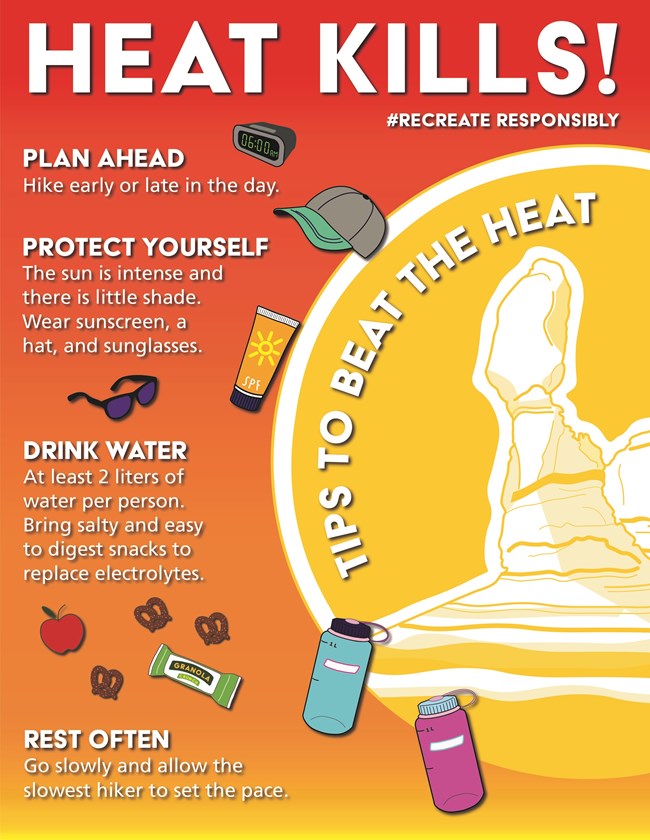Last updated: November 13, 2023
Thing to Do
Hiking at Arches

NPS/Veronica Verdin
Arches contains a variety of hiking trails, from easy/moderate to long and strenuous. Trails provide access to outstanding viewpoints and arches not visible from the road. Many trails use cairns (stacks of rocks) for markers and cross broad rock surfaces, requiring attention to follow.
Find lists of short, moderate, and longer trails in the What to See section of this app.
Protect Yourself
Each year, park rangers respond to hundreds of search or rescue incidents in the park. These frequently involve heat exhaustion, dehydration, climbing or scrambling and improper footwear.
We want your visit to be safe and enjoyable. Below are some of the potential hazards you may experience during your visit. Please become familiar with them, and keep them in mind while you're here.

NPS Graphic / Veronica Verdin
Heat & Sun
During the summer, expect high temperatures, intense sunlight and low humidity. Eat plenty of food and drink at least one gallon of water, per person, each day. Carry and drink water (at least 2 liters) during all activities in the park, such as hiking. Wear loose-fitting, light-colored clothing and a wide-brimmed hat. Apply sunscreen to all exposed skin. Avoid hiking in the middle of the day. Save strenuous activity for early mornings or evenings. You can get water at the visitor center and at the Devils Garden trailhead and campground.
Proper Footwear
Wear sturdy shoes with enough tread to give you good traction. Do not hike in smooth-soled shoes or boots. Some trails cover uneven terrain and follow rock ledges.
In winter, trails may be icy. We recommend you wear traction devices on your shoes.
Climbing & Scrambling
Slickrock invites adventure. When you climb or scramble, be sure you can retrace your steps. Climbing up is easier than climbing back down. Sandstone is slippery when wet or covered in sand. Do not climb or walk on arches or major features like Balanced Rock.
Staying Found
Stay with companions while hiking; separation can mean getting lost. Do not count on a cellular phone to summon help; cellular service will not reach into many areas of Arches. If you become lost, stay where you are and wait for rescue. Wandering will endanger your life and make finding you difficult. When traveling alone, always tell someone where you are going and when you expect to return.
Lightning & Flash Floods
Storms and flash floods can be powerful and sudden. When lightning is present, avoid lone trees, cliff edges and high ridges. Crouch low to the ground. Return to your vehicle if possible. Never try to cross a wash that is flooding. Read more on weather.
Black bears occasionally wander into the park from the nearby mountains.
After a snowfall, the park road may close for several hours for plowing. Park roads, parking lots, and pullouts can still be icy, especially in shaded areas.
Most hiking trails remain open year-round. After a snowfall, packed snow and ice make popular trails slippery. We recommend traction devices and trekking poles. Drifting snow can cover trail markers, making even "easy" trails harder to follow.
Even in colder temperatures, it is important to drink water. You can get water at the visitor center or Devils Garden Campground.
Protect Your Park and Leave No Trace
Watch Your Step.
Help us protect biological soil crusts during your visit. Please walk only on trails, rock or in sandy washes (where water flows when it rains), and keep all vehicles and bikes on designated roads.
Protect Ephemeral Pools.
Sandstone basins called ephemeral pools or potholes are home to a variety of life. Tiny organisms depend on the water in these shallow pools. To protect these life forms, please do not swim, bathe, or drink the water in desert potholes, and do not walk through dry ones.
Keep off the Arches.
To promote visitor safety and the opportunity to view natural features undisturbed, climbing, scrambling, walking or standing upon, or rappelling off any arch is prohibited in the park.
Leave the Rocks as You See Them.
Graffiti—carving, scratching, chalking, or any type of marking—is illegal and unsightly. If you see someone marking on the rocks, please report it to a ranger. Learn how to be a good visitor to archeological sites.
These areas are accessible to wheelchairs. All toilets in the park are accessible. Some trails are considered barrier free, which may contain minor obstacles, steeper grades, temporary washouts, and may require assistance. Rain and snow may cause ruts or other obstacles on the trail.
- Park Avenue Viewpoint: Flat, paved surface to a viewpoint.
- Balanced Rock: Flat, paved surface alongside Balanced Rock ends at a viewpoint.
- Balanced Rock Picnic Area: Picnic area is paved. Toilets are across a gravel road. Toilets are accessible.
- The Windows Trail: First 100 yards is flat, hardened surface and is considered barrier free. Nearby toilets, along a paved surface, are accessible.
- Double Arch Trail: Relatively flat, hard-packed trail is considered barrier free.
- Panorama Point: Viewpoint, picnic area, and stargazing area have paved surfaces. Toilets are accessible. Benches are available.
- Delicate Arch Viewpoint: Viewpoint has a flat, packed gravel surface. Picnic area and sidewalks are paved. Toilets are accessible.
- Wolfe Ranch: Path to Wolfe Ranch and petroglyph panel are flat with a gravel surface. Toilets are accessible.
- Devils Garden Campground Amphitheater: paved path connects parking area to the amphitheater with a view of Skyline Arch.
- Devils Garden: Trail to Landscape Arch has a hard-packed surface and is considered barrier free, however the trail has steep slopes and may require assistance. Picnic area and trailhead have paved surfaces and accessible toilets.
